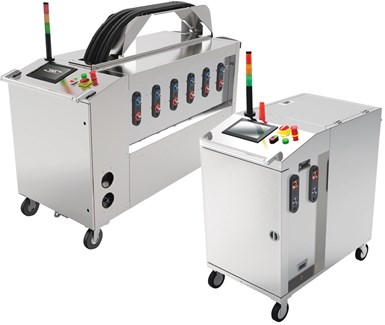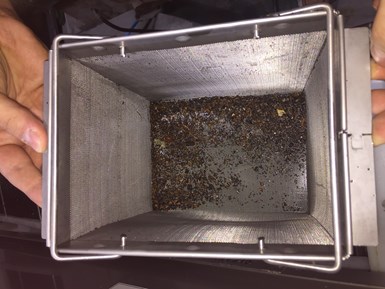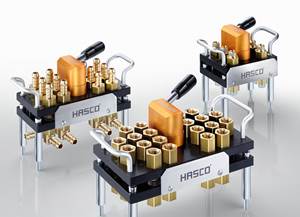System Offers 'Lights Out' Mold-Channel Cleaning & Diagnostics
New system automatically cleans mold-cooling lines—including conformal channels—removing rust and calcium, among other deposits, while simultaneously testing for leaks, measuring flow rate and applying rust inhibitor.
The new CoolingCare system from DME provides molders automated maintenance, diagnostics and conservation of cooling channels in a self-contained mobile unit. Mounted on casters and with two models available—with two and six channels—CoolingCare currently has two chemical cleaning formulas available. DS1, which is formulated to target deposits with high concentrations of iron oxide and corrosion by products; and DS2, for calcium- and magnesium-carbonate based buildup. Testing strips are available to customers to determine which formula they’ll require. CoolingCare was developed by Polish moldmaker Fado.

DME’s CoolingCare is available in two- and six-zone models.
Photo Credit: DME
Once a mold is attached, with the option to be hooked up inside or outside the press, the system automatically proceeds through six steps: leak test, blockage test, flow-rate diagnostics, cleaning, and reporting. Cleaning includes a rinse cycle and forced-air drying. The cleaning solution, which also acts as a rust inhibitor, is pulsed through the mold to augment its cleaning action—an aspect of the technology that is patented, according to DME. Cooling lines have air within them and when attached to typical cleaning systems with a standard pump, that air is compressed against the blockage and acts as buffer between the cleaning solution and the deposits.
“This system has diaphragm pumps that pulsate the liquid back and forth,” explains Mike McCutcheon, DME product manager. “So it’s not just pumping through the channels, it’s pulsating from both sides.” This action works the water and the chemicals into the blockage itself, moving any air bubbles out of the way so the chemicals can reach the blockage and break it up.
For a new tool, CoolingCare’s diagnostics can be used to establish a baseline flow rate against which the tool can be compared as it’s run. The CoolingCare system’s controller, which is based on a 10-in. touchscreen, can store data for 3000 molds, saving maintenance and cooling-performance history. For older tools, CoolingCare can run a check for air and water leaks, in addition to determining current flow rate. This can be useful for molders assessing the processing health of a transfer tool.
CONFORMAL COOLING CONUNDRUM

Within the filter basket, where the cleaning solution is initially loaded, contaminants removed from a cooling line after running DME’s CoolingCare system are visible.
Photo Credit: DME
While there are established means to clean other areas of a tool, cooling channels have historically posed some difficulty, often requiring gun drilling, which is typically outsourced and cannot help with smaller or nonlinear cooling lines. The deposits, which are far less thermally conductive than the metals they’ve accumulated on, impinge on the cooling system’s ability to remove heat from the mold, ultimately impacting cycle time and part quality.
“Once you get that buildup in the lines, it acts like an insulation blanket,” McCutcheon says. “This is when you start seeing longer cycle times and you have quality issues like warpage and burns.”
McCutcheon says the impact is particularly acute for molders utilizing conformal cooling channels. Smaller than typical cooling lines and featuring nonlinear paths, conformal cooling channels have proven particularly difficult to clean for many molders.
“We found some customers who were even making their own conformally cooled inserts and they got to a point where they stopped doing it, because they couldn’t find a way to clean them,” McCutcheon says. “There was no way to clean them efficiently, so they were forgoing the gain of the conformally cooled cycle times because they couldn’t clean them up.”
Because the CoolingCare system is closed-loop, it can run in lights-out fashion, cleaning a tool until the desired flow rate is achieved and then shutting off at that point, following rinsing and drying. “If you set the machine to run diagnostics for 4 hr,” says Patricia Ewald, DME associate product manager, “you could run a test once every hour and it’s going to give you feedback into how much flow rates improved in the first hour, second hour, etc..” With an optional SIM card, the machine can send text alerts to mobile devices, giving updates on testing as well as instant notifications on up to 17 different alarms. In addition to sending text alerts to users, molders can text the machine, requesting the status of the current cleaning cycle. They can also access reports online.
“A molder could hook up their tools on second or third shift, run it overnight and come back, and the machine will have shut off once it reached the setpoints that have been determined,” Ewald says.
CLEANING BEYOND COOLING LINES
DME notes that this machine is also capable of cleaning a variety of equipment on a shop floor, including the feed throat of a molding machine. “Many molders have seen or experienced ‘bridging’, or the melting of resin in the hopper before it enters the barrel,” McCutcheon says. “This is due to inefficient cooling of the feed-throat area caused by contaminants.” In addition, the CoolingCare system could also be used to clean chillers, water-temperature controllers and heat exchangers, according to McCutcheon.
Related Content
How to Reduce Sinks in Injection Molding
Modifications to the common core pin can be a simple solution, but don’t expect all resins to behave the same. Gas assist is also worth a try.
Read MoreMulticoupling Range Extended
Hasco‘s quick-connect system for multiple cooling circuits has added U.S., French and HT versions.
Read MoreChiller Lines Updated to EPA-Approved Refrigerants
Thermal Care’s chillers now utilize EPA-approved low Global Warming Potential (GWP) R‐454B and R‐513A refrigerants.
Read MoreNorth American Distribution for System to Track Cooling-Circuit Temperatures, Flow Rates
Globeius is now a North American supplier of Mouldpro’s Flosense 1.0 Flexible Flow Monitoring system for tracking manifold pressures and mold temperatures.
Read MoreRead Next
Making the Circular Economy a Reality
Driven by brand owner demands and new worldwide legislation, the entire supply chain is working toward the shift to circularity, with some evidence the circular economy has already begun.
Read MorePeople 4.0 – How to Get Buy-In from Your Staff for Industry 4.0 Systems
Implementing a production monitoring system as the foundation of a ‘smart factory’ is about integrating people with new technology as much as it is about integrating machines and computers. Here are tips from a company that has gone through the process.
Read MoreFor PLASTICS' CEO Seaholm, NPE to Shine Light on Sustainability Successes
With advocacy, communication and sustainability as three main pillars, Seaholm leads a trade association to NPE that ‘is more active today than we have ever been.’
Read More






















